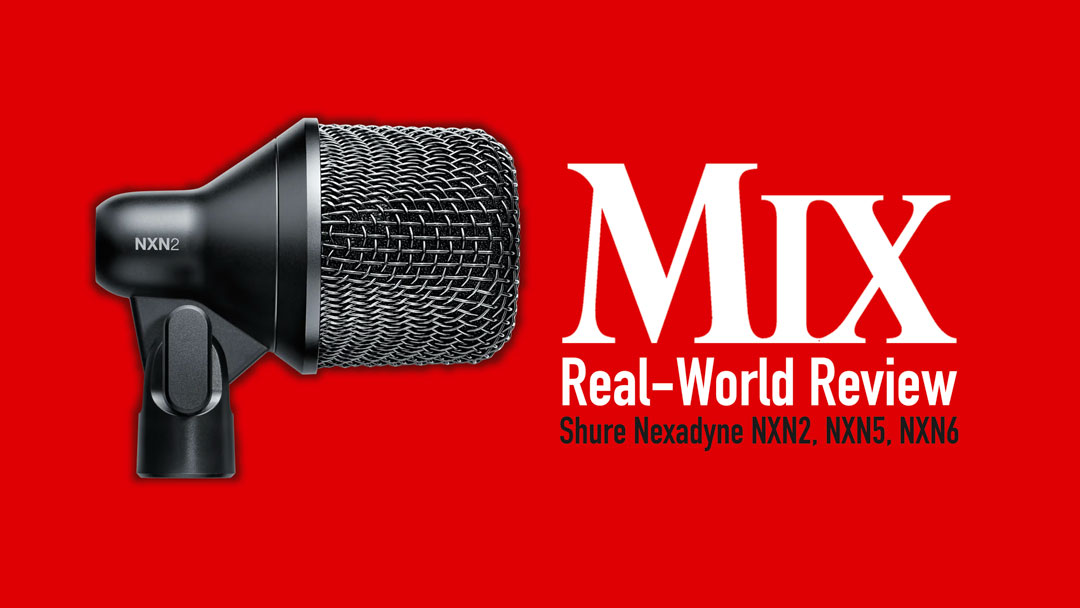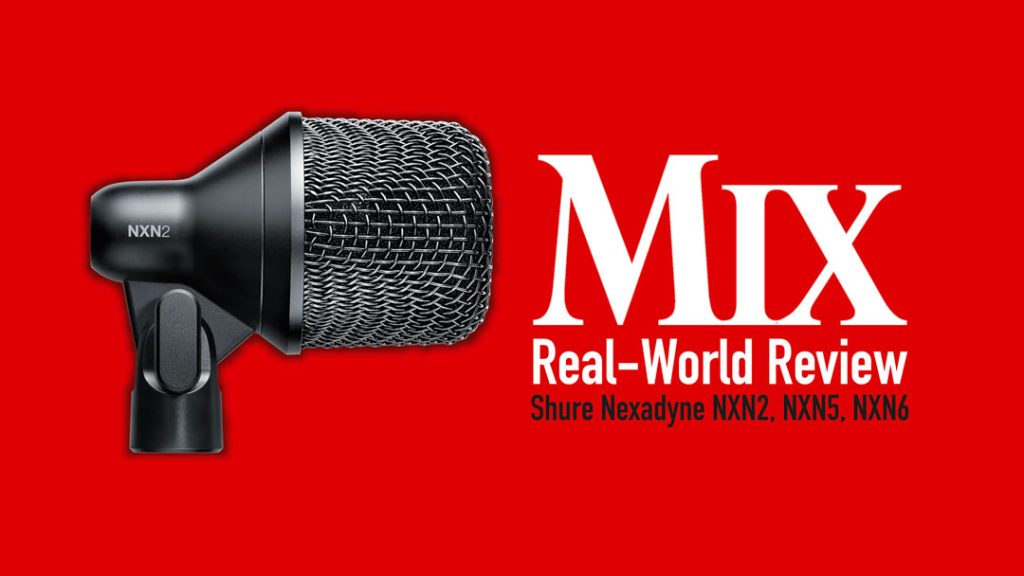
| MIX VERDICT: SHURE NEXADYNE NXN2, NXN5, NXN6 |
| THE TAKEAWAY: “These are precision tools, each with a consistent sound built to last. Great stuff!” |
| COMPANY: Shure • www.Shure.com PRICE: NXN2 $249, NXN5 $219, NXN6 $249 MSRP PROS: • Rugged drum mics that are voiced for kick, snare, toms—and electric guitars. CONS: • NXN6 could use an extra clip. |
New York, NY (August 14, 2025)—Shure launched the Nexadyne Series in 2022 with two handheld vocal mics: the 8C cardioid and 8S supercardioid. Three years later, at the 2025 NAMM Show in January, the company debuted three new dynamic models in the Nexadyne line: the NXN2 kick drum, NXN6 snare/tom and NXN5 for guitar amps.
Intended for both live sound and studio use, these are all supercardioid dynamics designed for close-miking individual drums within the kit, and for guitar amps. Making use of the company’s Revonic Dual-Engine Transducer Technology, each is voiced with a specifically contoured frequency response for its intended application.
Each Nexadyne mic employs two precisely calibrated transducers—one facing the source and the other placed directly behind it, facing backward, and wired out-of-polarity. The transducers are acoustically coupled with matched, vibrational responses, so when the vibrational energies from the front and back transducers are subtracted from one another, it cancels out mostly low frequencies, including mechanical noise and stage rumble.
Meanwhile, the mic’s internal shape provides off-axis cancellation of the mid/high frequencies coming into the rear transducer’s three screen vents. The presence boost in the NXN Series is produced acoustically, not electrically with an EQ.
The largest and heaviest of the three is the NXN2 kick drum mic. It differs from the others in that its XLR connector is positioned at the rear of the mic’s body, away from the swivel joint. It also has a heavier voice coil for an increased low-frequency response, along with a built-in, low-Q passive bandpass filter that scoops out 450 Hz. Its included frequency chart shows a broad boost centered at 4.5 kHz.
Discover more useful reviews—get a free Mix SmartBrief subscription!
The NXN5 and NXN6 incorporate the same dual-transducer system. However, because the space around the transducers is different, incoming sound is affected at different frequencies. The NXN5 grille ring and housing behind the transducer assembly causes a presence peak centered at 6 kHz.
For its intended use, hanging and draped over the front of a guitar cabinet, the mic’s handle is closer to the transducer and contours the high frequencies. In contrast, the NXN6 snare/tom mic’s presence peak is at about the same frequency but much wider and smoother.
All three mics have nearly the same sensitivity ratings at about -61 dBv/PA, or 0.9 mV/PA. The NXN2 is rated at -66 dBV/PA, or 0.5 mV/PA. All three have a tight-fitting, rubber sleeve surrounding the transducer, which acts as a shock absorber to reduce handling noise.
I tested all three mics in a recording studio with a 20 x 25-foot live room. I had the NXN2 and NXN6 mics placed on a mahogany drum kit. Soloing any of these while the drummer played showed off how well they rejected off-axis leakage from other drums in the kit and/or other loud instruments in the studio. Furthermore, whatever low-level leakage was there sounded good, and not phasey or filtered.
NXN2 KICK DRUM
The NXN2 is my favorite of the three. It is a compact bass drum mic that also could be used for a bass guitar amp. It weighs nearly two pounds and has its XLR connector located directly on its back. Great! No more hunting around the mic to find it.
I tried the NXN2 placed in three different positions on a 22×14-inch kick drum. All three positions sounded good and full, providing me with three slightly different options. Out in front of the kick, I got a fat sound with a good mix of subsonic energy and attack. The scoop at 450 Hz worked out well. Moving the mic all the way inside changed the tone, with fewer sub-frequencies and more of the sound of the drum’s shell. The best sound came with placement just inside of the hole in the front head—the mic’s grille was just through the hole and aimed at the beater.
NXN6 TOM/SNARE
The NXN6 is the smallest of the three new Nexadyne models, with a low profile that’s nearly invisible from the studio’s control room— or the audience’s perspective. It has a slender body bent at an acute angle relative to the aim of the transducer and windscreen. At the end of the mic is an XLR connector and enough space to attach a fully adjustable clip/mount (included). Providing vibration isolation, this stiff rubber clip attaches to the rim of any drum and allows placement in the tightest of places on the kit, all without using a mic stand.
On an 8×1212 rack tom, I first aimed the NXN6 at the closest lug. I liked the sound, although the attack was rolled-off; by re-aiming toward the center of the drum, it produced a thick tonality with plenty of attack. Between slightly angling the mic up/down and altering the pickup direction, I had plenty of choices when positioning.
On a snare drum, I clamped the NXN6 to the drum’s rim, near the snare release mechanism and protruding just inside the rim. I aimed from seven inches away from the center of the drum head. I quickly found that raising it just two inches increased the attack and high frequencies, capturing the snare drum’s sound well and with minimal hi-hat leakage, even with my drummer bashing the hat!
Switching the NXN6 over to the 14×14-inch floor tom produced a big, meaty sound with good transients. For the most part, the clamp worked well for the snare and floor tom, but on some rack toms, it can be limited in the places you can attach it, especially if your drummer uses rim isolating mounts. Shure sells (separately) the same clip used for its SM81, Beta 181 or KSM137 mics. Perhaps they should include one, as they did with the NXN5.
NXN5 GUITAR AMP
At first glance, the NXN5 is a strange-looking beast. The XLR mic cable plugs into the end of the mic’s L-shaped body, designed to drape down in front of an amp’s speaker. Its shape facilitates the old live sound technique previously accomplished by hanging a side-address dynamic microphone. For conventional mic stand/boom use, it also comes with a standard Shure mic clip.
I tried the NXN5 on a little combo amp. I threaded the XLR cable though, and locked it to the amp’s carrying handle. It was easy to find the sweet spot on this particular amp’s 12-inch speaker by pulling the cable up or down, or moving it side-to-side. The shape of the NXN5’s windscreen allowed it to rest flat and right on the grille cloth, halfway between the speaker’s suspension and the dust cap.
AKG K712 Pro Headphones — A Mix Real-World Review
The NXN5 has a good, clean sound, with a little more midrange “cut” to counteract the proximity effect of it being so close to the speaker. The mic’s design suppresses external vibration—such as when you drape it in front of, and touching, a guitar amp’s grille cloth.
The three Nexadyne dynamics provide a good, solid start to a microphone collection that is equally suited for both the studio and stage. I like the rugged heft of these mics, with their cast-aluminum bodies and their tough, screw-on, steel-mesh windscreens that are not easily dented. These are precision tools, each with a consistent sound built to last. Great stuff!

